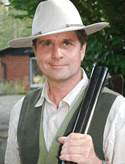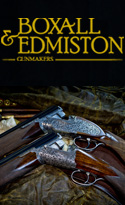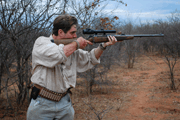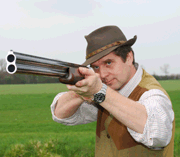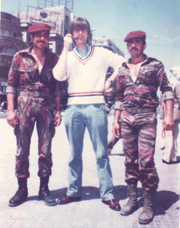Beretta DT11 Gun Test by Mike Yardley
I am testing a particularly impressive new gun this month: the new Beretta DT11. That positive comment gives the game away a bit, but I am so impressed with the shooting qualities of the gun that it is appropriate to give it a bit of a plug right from the outset. When Beretta launch a new model, it is quite a big deal, all the more when it is a gun that might be used in competition at the highest level, as the DT11 is intended for. One expects something good.
The DT10, the gun the DT11 replaces had a lot of fans, but this hefty new clay cruncher, though based on a very similar, if thicker, action, has sufficient new features to be considered a distinct new model rather than a mere exercise in cosmetic re-badging. So, a good place to start here would be a consideration of the differences between the two. I will briefly note first that the DT10 stands apart from the rest of the Beretta range, SO sidelocks and the old (and mounted ASE) excepted, in having an action with top extensions unlike the ubiquitous (and brilliant) Silver Pigeons.
OK, so what has the DT11 got that is really new? We'll start with what is obvious to the eye. The nickel plated action, which is part matt and part polished, and has blue fill to its border engraving. Aesthetically I was not sure about the latter, but the two tone appearance was appealing. It is also 3mm wider than the DT10. This adds mass - several ounces - in the middle to what is generally a heavier gun than the DT10 (ours weighed in at about 8 ½ pounds). Perhaps the most significant change in the DT11, though, is the incorporation of a new system of boring which combines an element of something like back-boring with an extended taper.
Three quarters of the length of the 'Steelium' barrel is a taper in fact. So, it is rather like a massively extended forcing cone, then there is a minimal length of nominal bore before the choke area is reached. There are slightly different boring plans for the multichoked sporter and the fixed choke trap gun (as tested). The former ends with a bore diameter of 18.6mm before the lead into the choke area, whilst the trap gun is 18.4mm with chokes of three-quarters and full.
This taper boring prompts various observations and comments. First, it is a very old concept dating back several hundred years at least. It was rediscovered in the Victorian with guns like Lang's 'Venacontracta' – a 12 which contracted to a 20 near the muzzles – and, much more recently, Fabarm have offered 'Tri-bored' guns (which have stepped bores which contract towards the muzzles). Taper boring has been used both to improve (allegedly some might say) pattern quality and to reduce weight in some guns. In the DT11, it is used for the former purpose and combined in the sporting model with Optima HP long, thin wall, extended multi-chokes.
We might as also note here that the stock of the DT11 (which is made from good quality of wood which is oil finished in traditional style) is more amply proportioned than that of the DT10. Another new feature of the DT 11's concerns it's 'Microcore' recoil pad. This is made from an ultralight weight polymer with a honeycomb structure. It is notable not just for its extreme lightness, but for its impact reduction qualities. Browning are offering something similar on their 725.
Technical
Well we have covered most of it. The forged, CNC machined, DT11 action, like the DT10 dispenses with the conical bolts of the Silver Pigeon range, but retains a similar hinging system with studs near the knuckles. The action is a bit wider in the fences (a feature which has never particularly appealed to me). Like the DT10 and ASE, the DT11 has a detachable trigger unit with v main springs powering the hammers. The hammers themselves are very similar to those in an SO, and, like an SO the triggers may be adjusted to give very crisp trigger pulls. The single trigger mechanism is inertia operated. No change there, but the shapes of safety and top lever have been changed to improve ergonomics.
On the barrel front it is notable that the trap gun has standard proof (most Berettas have fleur-de-lys superior proof now) and 2 3/4” chambers. The barrels are made of new alloy steel Beretta call Steelium as previously noted. They are manufactured by a new process which is a mixture of hammer-forging (as most Beretta barrels are now made), deep drilling, and vacuum stress-relief.
Shooting Impressions
Well, let's not hold back – simply fantastic! This is a gun which seems to turn clay birds into balls of smoke effortlessly. It is soft in recoil and the patterns, as far a could judge without extended plating, were exceptional. The gun is big even with the 30” tubes as tested. The stock shapes generous with a large thick comb and a big, quite tightly angled, grip. The comb is also high as one expects in a trap gun (drop at comb was 28mm with 42mm at heel – on the cast front there was 4mm right hand cast at heel and 6mm at toe). I would not normally have chosen a gun quite as high for myself, but it worked brilliantly on DTL. I would have love to use it on OT as well, but that will have to wait. Meantime, this is probably the best competition gun Beretta have yet made. I'd like to see the same barrels on a 682, but we can all dream. For the quality and performance, the £6K+ of the DT11 did not strike me as extortionate. There are some interesting options too. You can get guns with adjustable stocks, left handed stocks, and guns with headed stock blanks. All showing that Beretta are taking competitive shooting very seriously.
My thanks to Lyalvale Express for supplying the cartridges used in this test
We Like
The Performance
The Lack of Recoil
The Solid Build Quality
We Don't like
The blue go faster stripes
Technical Specification
Make: Beretta
Model: DT11 Trap
Bore: 12
Chamber: 2 3/4” (70mm)
Barrels: 30” fixed choke (32” option)
Rib: 10mm
Weight: 8 ½ lbs. approx.
RRP.: £6,550


